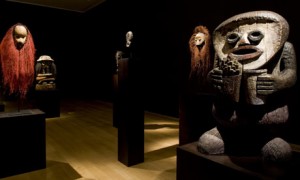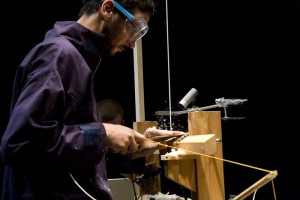Craft, Reimagined
What does the word ‘craft’ now mean? With Grayson Perry and other contemporary artists reclaiming craft as a key part of their practice, Heather Garner reimagines the term, looking for examples of subversion, and wondering whether the satisfaction gained from the process of making things is actually all that matters…
Craft, since the advent of Conceptualism, has somehow found itself in a rather awkward position. The contemporary art movement has gradually and ruthlessly placed idea or concept over process or technique in order of importance. However, this way of thinking has begun to shift; with major British institutions placing craft firmly in the spotlight — Tate Britain’s British Folk Art exhibition, and Grayson Perry’s new show Who Are You? at the National Portrait Gallery — questions of craftsmanship within art have again become pertinent. How does craft now manifest itself in contemporary art? And, without it, is a certain level of individuality lost?
In its broadest sense, craft is simply the taught skill involved in making something by hand. Yet gradually, over the last century, the word ‘craft’ has come to be associated with a pastime or hobby, the domestic (or amateur), and the handmade. Craft now says twee knitting circles, yarn bombing and artisan beer brewing. In other words, it has become the antithesis of cutting-edge contemporary art.
Craft is often understood in terms of its materiality and its functionality; as the artist David McClyment (above) stated: “Craft gives you a pot to piss in: art gives you something to piss on”. Here, McClyment betrays something of the attitude towards contemporary art; as something that is intended to stir emotions and to challenge and confront the viewer. It was an idea originally championed by the King of Concept, Dada artist Marcel Duchamp, who started to imbue found objects with intellectual ideas and provocations; such as the urinal in his seminal work Fountain (1917).
In summary, art and craft have been clearly divided.
However, pitching art and craft against each other as materiality versus concept somehow seems to miss the bigger picture. The Chapman Brothers Family Collection (2002) — wooden carvings that surreptitiously reference commodity culture and fast food chains — and Turner Prize winner Simon Starling’s re-assembled and re-appropriated Shedboatshed (2005), plus Ai Weiwei’s Sunflower Seeds (2010) — individually hand-carved by hundreds of Chinese workers – all directly employ craft or craftsmanship.
One major example of a contemporary artist mastering both materiality and concept is, of course, Grayson Perry: the artist’s clay vessels and tapestries manage to be both beautifully made whilst conveying intricate and narrative-driven subject matter, such as class, politics and autobiography. Perry blurs the lines between the functional and concept-driven artwork, thereby bringing what is ostensibly a craft object into the contemporary gallery space.

From Perry, Ai Weiwei and more we can gather that the utility of craft in contemporary art is more than mere functionality. If craft is simply the taught skill involved in making something by hand, it can also be an important part of the concept; in the latter’s case, a reference to manual labour and the ‘Made In China’ phenomenon. Richard Sennett in his seminal book The Craftsman (2008) discusses how the physical process and skill of making and the satisfaction gained from the process of making things well is, in some cases, all that matters.
Furthermore, the patience and time that is involved in learning a skill can hold a deep connection between the hand and the head: to quote Immanuel Kant as Sennett does: “The hand is the window on the mind”. From this, we can infer the importance of hand-crafting as a means of individual expression that can never be recreated by another. In an age of flat-pack furniture, instant messaging, microwave meals and Pro-Tools, it is easy to understand why some may feel that the time, skill and patience that is involved in the physical act of making an object may be seen as a dying art. In this sense, is craft the key to individuality in art?
Although this is hardly a new observation, there seems to be an ever-increasing desire to return to more traditional forms of making in contemporary art, and therefore highlighting the individuality that can be achieved as a result of employing such time-consuming processes.
Manchester-based artist collective The Owl Project — comprised of artists Simon Blackmore, Antony Hall and Steve Symons — draw inspiration directly from traditional craft techniques yet remain steeped in contemporary technology. This intertwining creates a juxtaposition between old and new; and most evident in SoundLathe (2009). In this piece, the process of wood turning, whereby a piece of wood is carved and shaped on a traditional turning lathe, produces a uniquely shaped object that cannot be replicated. This carving process simultaneously (and satisfyingly) becomes an instrument through which electronic sound is created.

Through such a hand-crafted procedure, it is impossible to recreate identical wooden objects or, by extension, sound compositions each time it is used. With this process, every hand movement, every touch of metal on wood, and every slip of the hand, are encoded in the grooves, and the glitches and electronic beats that emanates from it.
The long arm of craft can also be extended to the 20th century medium of analogue film. Before digital, analogue filmmaking was created using reels of tape; edited by carefully cutting up and sticking back together sections of tape to create a complete series of images. Of course, this is an over-simplified description of the skill and precision that is involved in the creation of a film, but the point here is to highlight the physical craft involved.
Artist Tacita Dean uses analogue as a response to and a rejection of the digitisation of the filmmaking industry, on both the big screen and in the gallery space. Her work FILM, installed at Tate Modern’s Turbine Hall in 2011, was an attempt to demonstrate the individuality that can be achieved through the splicing of each individual frame and the hand-colouring of captured imagery. In this sense, the physical handling of the film is just as much a part of the artwork as the finished and installed work itself, and is akin to the way in which Jackson Pollock handled paint: as a means of individual expression.
Although traditional references to craft have, in recent history, received scorn from the artistic community as being a lesser form of creative practice, the skill of hand-crafting can be found in unlikely areas of contemporary artistic practice. And, in some cases, can provide a window on to the mind and expressive qualities of the individual.
Whether or not the traditional concept of textiles, ceramics or wood perseveres in a digitally dominated era, craft is still open to subversion and transformation as any tool in the artist’s toolkit.
Heather Garner
Catch Grayson Perry’s Who Are You? exhibition at the National Portrait Gallery, London until 15 March 2015 — open daily 10am-6pm; Thursdays and Fridays until 9pm (free entry)
Watch episode three of Perry’s Channel 4 series Who Are You? on Wednesday 5 November 2014, and more episodes on 4OD





